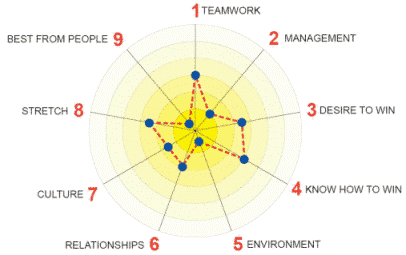Measuring Innovation Potential
Breaking down Innovation into components such as those defined in our Innovation Equation has one big advantage. All of these things are measurable, so your organisation can see the benefits of any innovation project that it undertakes. Because the areas examined are related to ‘soft skills’ the same techniques can also be used to measure the effects of cultural change programmes. Although the results are not directly comparable between organisations, the trends shown in the graphical outputs are, thus it is possible to spot both problem areas and areas of excellence as well as learning from your competitors. Find out how you can measure innovation potential and kick start your own programme using our Innovation Toolkit .
The advantage of our approach is that you do not necessarily need to spend money across the whole organisation. Scarce resources can be carefully targeted so that you get the best value for your money.
Our toolkit is an extension of the Innovation Equation. It allows us to measure drivers for Innovation in 3 key areas:
- Innovation environment (culture, risk, leadership and management, barriers etc)
- Creativity (how organisations generate and manage ideas and solve problems)
- Knowledge (the things you already know and how you make use of this and learn).
The information provided here is just an overview. A brief overview is available in PDF format by clicking on the link below. If you require more detailed information then please get in touch. We can provide detailed information as well as an example report of the type suitable for presenting to a Board of Directors or Top Management Team. Information on all of our products and services is available in PDF format via our Downloads page.
The Innovation Toolkit – the ONLY useful way to determine the Innovation capacity of your organisation
Benefits of using the Innovation Toolkit :
- Demonstrates your current capacity for Innovation
- Highlights areas for improvement
- Can be administered in a number of ways
- Requires minimum time investment from staff
- Provides a comprehensive report and action plan
- Allows for variable cost options
- Complements existing tools
- Works at all levels within an organisation
As a result of managing Innovation effectively you will:
- Generate better ideas
- Retain ideas and know-how within your organisation
- Remove or reduce the barriers that exist within your organisation
- Create an improved working environment
I’m interested, what do I do now? Just talk to us. We will advise you as to the best method of conducting the surveys and the exact cost of doing so. Please also read the remainder of this page.
The need for a measurement tool
In the current economic climate there is significant pressure to produce greater output for the same cost or for the same output at reduced cost. Either way we must find alternative ways of providing products and services to our customers.
In order to manage Innovation successfully you need to be able to define it within your own environment and then measure it. We use an Innovation model which is flexible enough to do this and which leads logically to the Innovation Toolkit.
What does the Innovation Toolkit consist of?
The toolkit consists of three phases; Analysis, Action and Review. During the Analysis phase your organisation is analysed using a set of surveys that can be administered either by you or ourselves in a number of different ways. The results are then compiled into a comprehensive report.
The Innovation report
The report is created using the results from 4 different types of survey. The first shows the overall Innovation capacity. Examples of the graphical output are shown below.

Fig 1 – A successful low cost airline

Fig 2 – A major international airline
The two plots above compare two airlines and give clues as to the major differences between them. Each plot represents a target, the closer to the centre they are, the more ‘ideal’ the innovation climate.
The Creativity and Knowledge climates are analysed in detail and the trends shown using more traditional graphs. Finally, the advice, trust and communications networks can be analysed in the context of the current state of the organisation and any changes that are currently being made.
How are the surveys carried out?
Depending on the number of staff involved, the time investment required from each person can be as little as 15 minutes or less. The surveys can be completed using pen and paper, a Microsoft Word template, individual interviews or group workshops. The method used depends entirely on your need or circumstances. We can advise you of the best method for your organisation.
